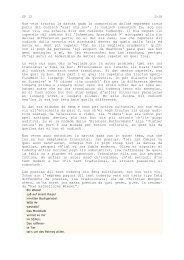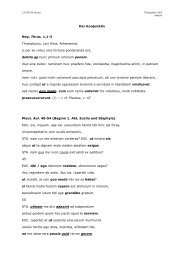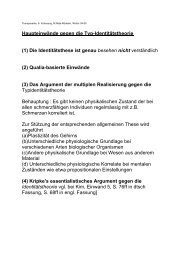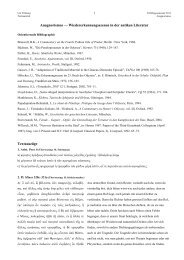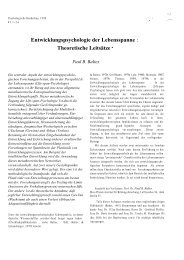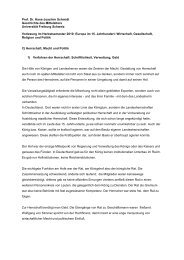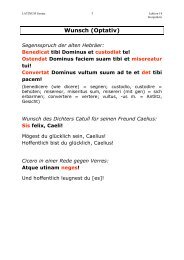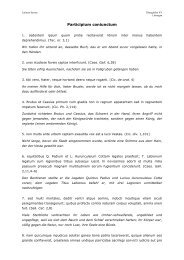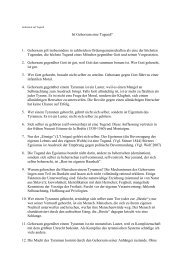The irrationality of recalcitrant emotions - Commonweb
The irrationality of recalcitrant emotions - Commonweb
The irrationality of recalcitrant emotions - Commonweb
Create successful ePaper yourself
Turn your PDF publications into a flip-book with our unique Google optimized e-Paper software.
Philos Stud<br />
DOI 10.1007/s11098-008-9241-1<br />
<strong>The</strong> <strong>irrationality</strong> <strong>of</strong> <strong>recalcitrant</strong> <strong>emotions</strong><br />
Michael S. Brady<br />
Ó Springer Science+Business Media B.V. 2008<br />
Abstract A <strong>recalcitrant</strong> emotion is one which conflicts with evaluative judgement.<br />
(A standard example is where someone is afraid <strong>of</strong> flying despite believing that it poses<br />
little or no danger.) <strong>The</strong> phenomenon <strong>of</strong> emotional recalcitrance raises an important<br />
problem for theories <strong>of</strong> emotion, namely to explain the sense in which <strong>recalcitrant</strong><br />
<strong>emotions</strong> involve rational conflict. In this paper I argue that existing ‘neojudgementalist’<br />
accounts <strong>of</strong> <strong>emotions</strong> fail to provide plausible explanations <strong>of</strong> the <strong>irrationality</strong> <strong>of</strong><br />
<strong>recalcitrant</strong> <strong>emotions</strong>, and develop and defend my own neojudgementalist account. On<br />
my view, <strong>recalcitrant</strong> <strong>emotions</strong> are irrational ins<strong>of</strong>ar as they incline the subject to<br />
accept an evaluative construal that the subject has already rejected.<br />
Keywords Emotions Recalcitrance Judgementalism Neojudgementalism<br />
Rationality Attention<br />
A <strong>recalcitrant</strong> emotion is one that is said to conflict with or run counter to evaluative<br />
judgement. In particular, a <strong>recalcitrant</strong> emotion is one that persists ‘‘despite the<br />
agent’s making a judgement that is in tension with it… A <strong>recalcitrant</strong> bout <strong>of</strong> fear,<br />
for example, is one where the agent is afraid <strong>of</strong> something despite believing that it<br />
poses little or no danger.’’ 1 In addition to fear, there are clear cases <strong>of</strong> <strong>recalcitrant</strong><br />
anger, guilt, jealousy, and shame.<br />
<strong>The</strong> phenomenon <strong>of</strong> emotional recalcitrance raises an important problem for<br />
theories <strong>of</strong> emotion, which is to explain the sense in which <strong>recalcitrant</strong> <strong>emotions</strong><br />
involve rational conflict or tension. For we have an intuitive sense that there is<br />
1 D’Arms and Jacobson (2003, p. 129).<br />
M. S. Brady (&)<br />
Department <strong>of</strong> Philosophy, University <strong>of</strong> Glasgow, 69 Oakfield Avenue, Glasgow G12 8QQ,<br />
Scotland, UK<br />
e-mail: m.brady@philosophy.arts.gla.ac.uk<br />
123
something wrong, from the standpoint <strong>of</strong> rationality, when fear persists in the face<br />
<strong>of</strong> a subject’s judgement that she is in little or no danger. In such a situation, we<br />
think that the subject should either stop being afraid, or should change her<br />
evaluative judgement. If she does not, then it seems as though the subject is<br />
violating some normative principle governing the relation between <strong>emotions</strong> and<br />
evaluations. A condition <strong>of</strong> adequacy on a theory <strong>of</strong> emotion is that it should be<br />
capable <strong>of</strong> capturing such normative principles, and thus capable <strong>of</strong> explaining just<br />
why it is that <strong>emotions</strong> are irrational when they violate such principles.<br />
In this paper I argue that a ‘neojudgementalist’ account <strong>of</strong> the <strong>emotions</strong> can<br />
explain the <strong>irrationality</strong> <strong>of</strong> <strong>recalcitrant</strong> <strong>emotions</strong>, by appeal to the idea that<br />
emotional feelings prime or incline one to accept an evaluative construal. In Sect. 1<br />
I argue that judgementalism is implausible on the grounds that it imputes too much<br />
<strong>irrationality</strong> to those suffering from <strong>recalcitrant</strong> <strong>emotions</strong>, whilst simple versions <strong>of</strong><br />
neojudgementalism are implausible because they fail to impute enough <strong>irrationality</strong><br />
to subjects <strong>of</strong> emotional recalcitrance. In Sect. 2 I consider, and reject, two recent<br />
neojudgementalist attempts to explain the sense in which <strong>recalcitrant</strong> <strong>emotions</strong><br />
involve rational conflict. And in Sects. 3–5 I propose, develop and defend my own<br />
neojudgementalist explanation.<br />
1 Judgementalism and neojudgementalism<br />
M. S. Brady<br />
It is widely accepted that there are close links between <strong>emotions</strong> and evaluative<br />
judgements. Thus, when a subject judges that she is in danger, then this usually<br />
suffices for her to feel fear; and when she realises that her situation is actually safe,<br />
then typically her fear will disappear. Judgementalism is a theory which proposes a<br />
very close link between <strong>emotions</strong> and evaluative judgements, by claiming that<br />
<strong>emotions</strong> simply are—or embody—such judgements. On a judgementalist account,<br />
to fear x is (at least in part) to judge that x is dangerous; to feel guilty about x is to<br />
judge that x represents a (moral) wrong on one’s part; and so on for other <strong>emotions</strong><br />
such as anger, grief, joy, and shame. 2<br />
However, judgementalism is committed to an implausible account <strong>of</strong> the<br />
<strong>irrationality</strong> <strong>of</strong> <strong>recalcitrant</strong> <strong>emotions</strong>. Since subjects who suffer from <strong>recalcitrant</strong><br />
<strong>emotions</strong> do not consciously assent to the judgement that is supposedly constitutive<br />
<strong>of</strong> their emotion, judgementalists must maintain that the relevant judgement is<br />
unconsciously held. This is criticisable on two counts: first, it imputes too much<br />
<strong>irrationality</strong> to the subject <strong>of</strong> emotional recalcitrance; second, it violates a principle<br />
<strong>of</strong> logical charity in our ascription <strong>of</strong> mental states. On the first count,<br />
judgementalism implies that someone who suffers from <strong>recalcitrant</strong> fear, let us<br />
say, displays an incoherent evaluative pr<strong>of</strong>ile with respect to the question <strong>of</strong> whether<br />
some object is dangerous. But as Bennett Helm has written, ‘‘conflicts between<br />
<strong>emotions</strong> and judgements do not verge on incoherence, for they are readily<br />
2<br />
Proponents <strong>of</strong> judgementalism include Solomon (1977); Lyons (1980); Marks (1982); and Nussbaum<br />
(2001).<br />
123
<strong>The</strong> <strong>irrationality</strong> <strong>of</strong> <strong>recalcitrant</strong> <strong>emotions</strong><br />
intelligible and happen all too <strong>of</strong>ten.’’ 3 On the second count, Patricia Greenspan has<br />
argued that positing the existence <strong>of</strong> unconscious evaluative judgements is a ‘‘last<br />
resort from the standpoint <strong>of</strong> explanation.’’ This is because we can assume ‘‘that the<br />
agent is functioning quite rationally in general, so that our ascription <strong>of</strong> beliefs to<br />
him ought to be governed by the principle <strong>of</strong> ‘logical charity.’ We need some<br />
special reason…for attributing to him an unacknowledged judgement in conflict<br />
with those he acknowledges.’’ 4 Since the only reason the judgementalist seems to<br />
provide for this attribution stems from their adherence to the judgementalist theory,<br />
their explanation <strong>of</strong> <strong>recalcitrant</strong> <strong>emotions</strong> is undermined. 5<br />
In light <strong>of</strong> this, theorists <strong>of</strong> emotion have sought to accommodate or recognize the<br />
close links between <strong>emotions</strong> and evaluations, but in a way which allows <strong>emotions</strong><br />
and evaluative judgements to diverge or come apart. One attempt to do so, which is<br />
increasingly prominent in the literature, is to maintain that <strong>emotions</strong> involve, not<br />
evaluative judgements, but evaluative perceptions or feelings or construals or<br />
thoughts. Such attitudes represent the attempt to accommodate the link between<br />
<strong>emotions</strong> and evaluations within ‘‘a broader evaluative view, allowing for<br />
propositional attitudes that are weaker than strict belief: states <strong>of</strong> mind, like<br />
imagining that danger looms, that involve entertaining a predicative thought without<br />
assent.’’ 6 On this ‘neojudgementalist’ view, the subject <strong>of</strong> an emotional experience<br />
construes or thinks <strong>of</strong> an object in an evaluative way; this constitutes an evaluative<br />
‘take’ on the situation which falls short <strong>of</strong> fully-fledged evaluative judgement. 7<br />
Now it is not easy to explain the nature <strong>of</strong> such evaluative construals or thoughts.<br />
Nevertheless, there are examples which help to illustrate the kind <strong>of</strong> thing involved<br />
in evaluative construal. Thus, I might construe a duck-rabbit figure as a duck at one<br />
time and as a rabbit at another; I might see a face in terms <strong>of</strong> another, as when I see<br />
my father’s face reflected in my own; I can think <strong>of</strong> a chimpanzee in human terms; I<br />
can have the impression that the person behind me in the queue is standing too<br />
close; and so on. 8 <strong>The</strong>se examples suggest that construals can involve a number <strong>of</strong><br />
different elements gathered from perception, imagination, conception, and thought.<br />
Thus, construals ‘‘have an immediacy reminiscent <strong>of</strong> sense perception. <strong>The</strong>y are<br />
impressions, ways things appear to the subject…they are experiences.’’ 9 But they<br />
are not identical with sense perceptions: to see my father’s face reflected in mine<br />
isn’t literally to have a visual sensation <strong>of</strong> its being that way. Moreover, to think <strong>of</strong> a<br />
chimpanzee in human terms owes as much to imagination and conceptual thought as<br />
it does to perception. On this account, construals are ‘‘a hard-to-specify structure <strong>of</strong><br />
3 Helm (2001, p. 42).<br />
4 Greenspan (1988, p. 18).<br />
5<br />
This argument has been widely accepted. For a dissenting voice in the judgementalist camp, see<br />
Nussbaum (2001).<br />
6 Greenspan (1988, p. 3).<br />
7 I prefer the term ‘neojudgementalist’ to D’Arms and Jacobson’s ‘quasijudgementalist.’ <strong>The</strong><br />
‘neojudgementalist’ camp includes de Sousa (1991), Roberts (2003), Greenspan (1988), Stocker and<br />
Hegeman (1996), and Calhoun (1984), amongst others.<br />
8 <strong>The</strong>se kinds <strong>of</strong> example are due to Roberts (2003, pp. 70–74).<br />
9 Roberts (2003, p. 75).<br />
123
percept, concept, image, and thought.’’ Although hard-to-specify, this should not<br />
make them mysterious; for they share this feature with ‘‘most <strong>of</strong> our experiences, as<br />
well as most <strong>of</strong> our unconscious states <strong>of</strong> mind.’’ 10<br />
Even if the precise nature and structure <strong>of</strong> construals is hard to specify, it appears<br />
that neojudgementalism represents an improvement on judgementalism. To see this,<br />
note that neojudgementalists can allow for the intelligibility <strong>of</strong> conflict between<br />
<strong>emotions</strong> and evaluative judgements, on the grounds that construals are evaluations<br />
but are not evaluative beliefs. <strong>The</strong> fact that x appears to me as U, or that I see x as U,or<br />
construe x as U, or think <strong>of</strong> x as U, does not entail that I believe that x is U or judge that<br />
xisU. In order for me to believe that x is U, I need to assent to the appearance,<br />
endorse the way things seem, accept the construal. 11 Applying this to <strong>recalcitrant</strong><br />
<strong>emotions</strong>, neojudgementalists can maintain that it is perfectly intelligible for me to<br />
construe x as dangerous (say), whilst believing that x not dangerous; they can<br />
therefore allow for the existence <strong>of</strong> <strong>recalcitrant</strong> <strong>emotions</strong> without implying that those<br />
experiencing a bout <strong>of</strong> <strong>recalcitrant</strong> emotion display an incoherent evaluative pr<strong>of</strong>ile,<br />
and without violating a principle <strong>of</strong> charity in ascribing mental states.<br />
But neojudgementalism suffers from its own failings. Whereas judgementalism<br />
imputes too much <strong>irrationality</strong> to someone experiencing <strong>recalcitrant</strong> emotion,<br />
neojudgementalism fails to impute enough. After all, it is not obviously irrational<br />
for one to see or construe or think <strong>of</strong> a situation as thus-and-so whilst believing that<br />
it is not thus-and-so. For example, it is not irrational for me to have the impression<br />
that my cat can understand what I’m saying to her, or to construe a gesture as rude,<br />
whilst believing that my cat cannot understand me, or and that the gesture was not<br />
rude. Merely construing or seeing one’s situation as thus-and-so, when one judges<br />
that it is not thus-and-so, seems insufficient for one to be subject to a charge <strong>of</strong><br />
<strong>irrationality</strong>. <strong>The</strong> neojudgementalist thus owes us an explanation <strong>of</strong> how and why<br />
evaluative construals can rationally conflict with evaluative judgements in cases <strong>of</strong><br />
<strong>recalcitrant</strong> emotion. Failing this, neojudgementalism does not seem to mark an<br />
improvement, from the standpoint <strong>of</strong> explanatory adequacy, over judgementalism.<br />
How might the neojudgementalist respond?<br />
2 Two possible solutions: Roberts and Helm<br />
In the previous section we saw that judgementalism imputes too much <strong>irrationality</strong><br />
to subjects suffering from <strong>recalcitrant</strong> <strong>emotions</strong>, whilst neojudgementalism doesn’t<br />
impute enough. We thus seem, as Helm puts it, to face ‘‘a choice between two<br />
unsatisfactory alternatives: either we must be judgementalists and accept an overly<br />
strong conception <strong>of</strong> rational conflict between emotion and judgement, or we must<br />
be anti-judgementalists and give up hope <strong>of</strong> accounting for such conflict.’’ 12 In this<br />
section I’ll consider two recent attempts to steer a middle course between these<br />
options.<br />
10<br />
Ibid., p. 77.<br />
11<br />
See Roberts (2003, p. 84). See also Nussbaum (op. cit.).<br />
12 Helm (2001, p. 45).<br />
123<br />
M. S. Brady
<strong>The</strong> <strong>irrationality</strong> <strong>of</strong> <strong>recalcitrant</strong> <strong>emotions</strong><br />
2.1 Roberts<br />
Robert C. Roberts argues that construals, though necessary for emotion, are not<br />
sufficient. In addition, the subject’s construal or thought must impinge upon his or<br />
her concerns in order for the experience to be an emotional experience. Thus,<br />
emotional experience involves more than merely thinking <strong>of</strong> one’s situation as thusand-so;<br />
it involves caring about the situation so construed. In this way, a case <strong>of</strong><br />
<strong>recalcitrant</strong> emotional experience differs from the kind <strong>of</strong> non-emotional and<br />
arational ‘clash’ between construal and judgement that we considered in the<br />
previous section, and that we also find in some cases <strong>of</strong> visual illusion.<br />
For Roberts, it is this which grounds a difference in rationality between<br />
<strong>recalcitrant</strong> (or ‘phobic’) <strong>emotions</strong> and mere construals. He writes: ‘‘Why is the<br />
knowing phobic’s state <strong>of</strong> mind irrational, but not that <strong>of</strong> the knowing subject <strong>of</strong> an<br />
optical illusion? I say it is because the knowing phobic feels torn between his<br />
judgement and his emotion in a way that the knowing stick-viewer does not feel torn<br />
between his judgement and his visual experience. <strong>The</strong> latter is complacent and<br />
normal, taking the illusion in stride; the former is in trouble and goes to a therapist.<br />
Where does the trouble [for the phobic] come from? It comes from the fact that,<br />
unlike the impression <strong>of</strong> the stick, the impression <strong>of</strong> the phobic is a concern-based<br />
construal. <strong>The</strong> fear has a personal depth and life-disrupting motivational power that<br />
the illusion lacks. <strong>The</strong> bent stick is, at most, puzzling; the fear is personally<br />
compelling. This means that when the subject dissociates from his fear by denying<br />
its propositional content, it is like denying a part <strong>of</strong> himself, whereas denying his<br />
visual impression is not.’’ 13<br />
In this passage Roberts highlights a number <strong>of</strong> differences between <strong>recalcitrant</strong><br />
<strong>emotions</strong> and visual illusions, grounded in the fact that <strong>emotions</strong> are concern-based<br />
construals, and which are supposed to underlie the difference in rationality between<br />
<strong>emotions</strong> and illusions. Of particular importance are the claims that <strong>emotions</strong><br />
possess a ‘‘life-disrupting motivational power’’ that visual illusions lack, and that<br />
the subject <strong>of</strong> a <strong>recalcitrant</strong> emotion denies ‘‘a part <strong>of</strong> himself’’ whereas the subject<br />
<strong>of</strong> a visual illusion does not. <strong>The</strong> question is, however, whether these differences are<br />
sufficient to explain the relevant difference in rationality. It seems to me that they<br />
are not; I’ll consider them in turn.<br />
Roberts claims that because <strong>recalcitrant</strong> <strong>emotions</strong> are concern-based construals,<br />
they possess a personal depth and a life-disrupting motivational power which is a<br />
source <strong>of</strong> ‘‘trouble’’ for the subject <strong>of</strong> such <strong>emotions</strong>. But whilst it is true that<br />
concern-based construals can possess such power and can to this extent differ from<br />
visual illusions, it is not clear why this counts as an adequate explanation <strong>of</strong> the<br />
<strong>irrationality</strong> <strong>of</strong> <strong>recalcitrant</strong> <strong>emotions</strong>. This is because non-<strong>recalcitrant</strong> instances <strong>of</strong><br />
grief, anger and fear can also possess personal depth and life-disrupting<br />
motivational power, and yet do not count as irrational. (Think <strong>of</strong> the motivational<br />
life <strong>of</strong> someone who is devastated by genuine grief, for instance.) So the fact that an<br />
emotion has personal depth and life-disrupting motivational power does not<br />
necessarily mean that the emotion is irrational. Perhaps, then, the suggestion is that<br />
13 Roberts (2003, p. 92). See also Greenspan (1988, pp. 4–5).<br />
123
ecalcitrant <strong>emotions</strong> involve a particularly irrational form <strong>of</strong> disruption to our<br />
motivational lives, and that this is the real source <strong>of</strong> trouble for the subject <strong>of</strong> such<br />
<strong>emotions</strong>. But even if this is true, it merely shifts the explanatory burden: what now<br />
needs to be explained is what makes this form <strong>of</strong> disruption irrational. In the<br />
absence <strong>of</strong> a further story here, it is difficult to see how we can explain the<br />
<strong>irrationality</strong> <strong>of</strong> <strong>recalcitrant</strong> <strong>emotions</strong> simply by appeal to life-disrupting motivational<br />
force.<br />
Roberts’s second suggestion is more promising, since it highlights a distinctive<br />
feature <strong>of</strong> <strong>recalcitrant</strong> <strong>emotions</strong>—namely, the fact that they involve a clash between<br />
an emotional appearance and an evaluative judgement. Roberts holds that in such<br />
cases the subject dissociates from his emotion, and that this is ‘‘like denying a part<br />
<strong>of</strong> himself.’’ This is because <strong>emotions</strong> are concern-based construals, and a subject’s<br />
concerns and interests are part <strong>of</strong> who he is. Since visual illusions do not impinge<br />
upon one’s concerns, they do not involve this form <strong>of</strong> dissociation or denial.<br />
However, whilst it is also true that <strong>emotions</strong> are <strong>of</strong>ten ‘‘personally compelling’’ in a<br />
way that visual illusions are not, it is not obvious that there is anything irrational<br />
about denying a part <strong>of</strong> oneself. Clearly, the concern or interest upon which my<br />
emotional response impinges might be a part <strong>of</strong> myself that I ought to deny, at least<br />
in my present circumstances. If I’m a bank manager, for instance, I ought to<br />
dissociate from my desire to steal the bank’s money, and thus ought to deny the part<br />
<strong>of</strong> myself that has avaricious feelings when I consider how much money there is in<br />
the bank vault. Such a denial would only have the appearance <strong>of</strong> <strong>irrationality</strong> if I<br />
somehow both identify with and at the same time dissociate myself from the relevant<br />
concerns and feelings. Here my desire or concern would be a part <strong>of</strong> myself, not<br />
simply in terms <strong>of</strong> being one <strong>of</strong> my desires, but in terms <strong>of</strong> being a desire or concern<br />
that I endorse. But <strong>recalcitrant</strong> <strong>emotions</strong> need not involve such endorsement: I<br />
might feel ashamed at my son’s poor performance on the football field, without in<br />
any way endorsing the competitive urge which generates this emotional response.<br />
So this second suggestion also leaves us with an explanatory gap: we need to know<br />
why, exactly, denying a part <strong>of</strong> oneself counts as irrational.<br />
Roberts is right to stress that <strong>emotions</strong>, unlike visual illusions, are related to our<br />
concerns and interests; and he is right to point out that this fact underlies a number<br />
<strong>of</strong> differences between <strong>recalcitrant</strong> <strong>emotions</strong> and visual illusions. But it is not clear<br />
how or why these differences underlie a difference in rationality between<br />
<strong>recalcitrant</strong> <strong>emotions</strong> and visual illusions. In the absence <strong>of</strong> further explanatory<br />
work, therefore, it is not clear how the appeal to an element <strong>of</strong> concern helps the<br />
neojudgementalist to avoid our problem.<br />
2.2 Helm<br />
Bennett Helm maintains that we can only explain the <strong>irrationality</strong> <strong>of</strong> <strong>recalcitrant</strong><br />
<strong>emotions</strong> if <strong>emotions</strong> involve something like the assent involved in fully-fledged<br />
evaluative judgement. He thus claims that ‘‘<strong>emotions</strong> must be understood as a kind<br />
<strong>of</strong> assent if we are to make sense <strong>of</strong> rational conflict with judgement at all.’’ 14<br />
14 Helm (2001, p. 45).<br />
123<br />
M. S. Brady
<strong>The</strong> <strong>irrationality</strong> <strong>of</strong> <strong>recalcitrant</strong> <strong>emotions</strong><br />
However, <strong>emotions</strong> cannot involve the same kind <strong>of</strong> assent as we find in fullyfledged<br />
evaluative judgements, for otherwise the problems facing judgementalism<br />
would reoccur. 15 Helm’s solution is to deny that all assent is judgemental assent;<br />
instead, he wants us to embrace the idea <strong>of</strong> a distinctively emotional kind <strong>of</strong> assent,<br />
which he terms disclosive assent, and which is ‘‘implicit in the idea that <strong>emotions</strong><br />
are evaluative feelings: being pleased or pained by things being thus and so is a kind<br />
<strong>of</strong> acceptance that things really are that way, an acceptance that falls short <strong>of</strong> fullblown<br />
judgement.’’ 16<br />
But why is it that being pleased or pained by x constitutes a kind <strong>of</strong> assent to x<br />
being thus and so? After all, I might feel pleasure when I fantasize that I’ve won the<br />
lottery, or feel pain when I imagine what it would be like to lose a loved one,<br />
without this seeming to constitute my assenting, in any sense, to these thoughts or<br />
construals. Helm’s explanation involves the idea that <strong>emotions</strong> essentially involve<br />
rational commitments. 17 For instance, forward-looking <strong>emotions</strong> rationally commit<br />
one to having appropriate backward-looking <strong>emotions</strong>: fear that the dog will attack<br />
me rationally commits me to being relieved when it does not; hope that I win the<br />
lottery rationally commits me to feeling joy when my numbers come up. In<br />
particular, Helm thinks that <strong>emotions</strong> involve a focal commitment: this is a<br />
commitment to the value or worthiness <strong>of</strong> the object which is the focus <strong>of</strong> the<br />
emotion, and is a commitment which makes sense <strong>of</strong> transitional and other specific<br />
commitments. Thus, it is because I am committed to the value <strong>of</strong> bodily integrity<br />
that I fear that the dog will bite, and feel relieved when it does not; it is because I<br />
regard a financial windfall as worthwhile that I hope to win the lottery, and feel<br />
delighted when I do. Each emotion therefore involves a commitment to a ‘‘broad<br />
pattern’’ <strong>of</strong> <strong>emotions</strong>, as a result <strong>of</strong> a commitment to the value <strong>of</strong> the focus <strong>of</strong> that<br />
emotion. Now this commitment is experienced by the subject as an evaluative<br />
feeling, wherein the value or import <strong>of</strong> the emotional object ‘‘impresses itself upon’’<br />
the subject. 18 For Helm, this passive experience <strong>of</strong> value or import in emotion just is<br />
emotional or disclosive assent: to experience a commitment to a focal value just is<br />
to assent in an emotional way to things being evaluatively thus and so. 19 Emotions<br />
therefore involve assent to things being thus and so, ins<strong>of</strong>ar as they essentially<br />
involve rational commitments; but this assent nevertheless falls short <strong>of</strong> the<br />
cognitive assent characteristic <strong>of</strong> evaluative judgements.<br />
Let us assume, for the sake <strong>of</strong> argument, that <strong>emotions</strong> do involve a commitment<br />
to some focal value, which grounds commitment to a broad pattern <strong>of</strong> other<br />
emotional responses. Thus, in the previous example, fear <strong>of</strong> the dog essentially<br />
involves a commitment to bodily integrity, which grounds commitments to other<br />
emotional responses: hoping that the dog won’t bite, feeling relieved when it<br />
doesn’t bite, etc. Let us also assume, for the sake <strong>of</strong> argument, that being thus<br />
15<br />
Ibid.<br />
16<br />
Ibid.<br />
17 Helm (2001, Chap. 3, esp. pp. 67–71).<br />
18 Ibid., p. 80.<br />
19 For Helm, <strong>emotions</strong> involve assent to how things are, which is ‘‘a commitment to things being that<br />
way, where this is a commitment to…having the other felt evaluations.’’ pp. 70, 152.<br />
123
committed constitutes a kind <strong>of</strong> assent which falls short <strong>of</strong> cognitive assent. It does<br />
not follow from this, however, that Helm can explain the <strong>irrationality</strong> <strong>of</strong> <strong>recalcitrant</strong><br />
<strong>emotions</strong> in terms <strong>of</strong> a clash between emotional assent and judgemental assent. This<br />
is because we have good grounds to doubt that there is such a broad pattern <strong>of</strong><br />
rational commitments in the case <strong>of</strong> <strong>recalcitrant</strong> <strong>emotions</strong>. Suppose that I am<br />
committed to the value <strong>of</strong> bodily integrity. This commitment plausibly grounds<br />
certain others, namely the commitment to feel fear when bodily integrity is in fact<br />
threatened, or to feel relief when a genuine threat has passed, etc. But it is<br />
implausible to suppose that this commitment rationally grounds a commitment to<br />
feel fear with respect to an object that one knows is not dangerous, even if this<br />
object appears in some sense dangerous. A commitment to a certain focal value<br />
only plausibly grounds commitments to certain appropriate emotional responses if<br />
these emotional responses are themselves warranted, at least from the subject’s own<br />
perspective. By the same token, it seems false to claim that a <strong>recalcitrant</strong> forwardlooking<br />
emotion rationally commits me to having the appropriate backward-looking<br />
emotion: if I am clearly aware that a certain dog is harmless but I am nevertheless<br />
scared that it will bite me, it seems false to claim that I am nevertheless rationally<br />
required to feel relieved when the dog doesn’t bite me. 20 If this is the case, then we<br />
can doubt that <strong>recalcitrant</strong> fear necessarily involves a rational commitment to a<br />
pattern <strong>of</strong> emotional responses. So even if we can understand emotional or<br />
disclosive assent in terms <strong>of</strong> rational commitments, we cannot appeal to this kind <strong>of</strong><br />
assent in order to explain the <strong>irrationality</strong> <strong>of</strong> <strong>recalcitrant</strong> <strong>emotions</strong>. Helm’s<br />
explanation thus fails.<br />
3 Emotions as inclinations to assent<br />
M. S. Brady<br />
We have seen that <strong>emotions</strong> must involve more than mere evaluative construals if<br />
they are to come into rational conflict with evaluative beliefs. For Helm, this means<br />
that <strong>emotions</strong> must involve something like (but something falling short <strong>of</strong>)<br />
judgemental assent. But we have also seen that Helm’s attempt to explicate a<br />
specifically emotional kind <strong>of</strong> assent, by appeal to rational commitments, fails. It<br />
seems to me that a better option for the neojudgementalist at this point is to deny<br />
that <strong>emotions</strong> necessarily involve a kind <strong>of</strong> assent, and maintain instead that they<br />
necessarily involve something suitably related to assent. In this way, the<br />
neojudgementalist can maintain a close link between <strong>emotions</strong> and evaluative<br />
judgement, whilst avoiding a collapse into judgementalism. Let me explain.<br />
It is clear that emotional experience is typically passive: to say this is to say,<br />
with Helm, that when we feel an emotion the import <strong>of</strong> our situation impresses or<br />
thrusts itself upon us. Now there is a way to interpret this claim which is<br />
compatible with a neojudgementalist explanation <strong>of</strong> <strong>recalcitrant</strong> <strong>emotions</strong>. On<br />
this interpretation, to say that the import <strong>of</strong> a situation impresses itself upon S is<br />
20 Indeed, from the standpoint <strong>of</strong> rationality, the fact that I would feel relieved in this case makes matters<br />
worse, since I would now experience two instances <strong>of</strong> <strong>recalcitrant</strong> emotion instead <strong>of</strong> one.<br />
123
<strong>The</strong> <strong>irrationality</strong> <strong>of</strong> <strong>recalcitrant</strong> <strong>emotions</strong><br />
to say, roughly, that S is inclined to assent to or endorse this view <strong>of</strong> the<br />
situation. In other words, when S experiences an emotion she is subject to some<br />
kind <strong>of</strong> pressure to accept the relevant appearance; she leans towards accepting<br />
the evaluative thought, is tempted by this way <strong>of</strong> seeing the evaluative<br />
situation, is moved to endorse her evaluative construal. On this view, both the<br />
evaluative construal and the inclination to accept the construal are necessary<br />
constituents <strong>of</strong> <strong>emotions</strong>, rather than being related effects or typical accompaniments<br />
<strong>of</strong> <strong>emotions</strong>. Now this falls short <strong>of</strong> judgementalism, since it is<br />
perfectly possible for S to be inclined to assent to some construal without<br />
assenting to the construal (and indeed, whilst rejecting this evaluative picture <strong>of</strong><br />
her situation). This account <strong>of</strong> the <strong>emotions</strong> therefore allows for the possibility<br />
<strong>of</strong> <strong>recalcitrant</strong> <strong>emotions</strong> without imputing any incoherence to S’s evaluative<br />
system. But being inclined to assent to an evaluation is subject to rational<br />
appraisal in a way that merely entertaining or imagining an evaluation is not. If<br />
so, we have the means <strong>of</strong> explaining why <strong>recalcitrant</strong> <strong>emotions</strong> involve rational<br />
conflict, and so differ from cases where a subject merely entertains evaluative<br />
thoughts.<br />
In order to make this picture plausible, we first need to say something about<br />
what it is to be inclined towards accepting a proposition or construal. Obvious<br />
models here are provided by desire and belief. Desire is the motivational state,<br />
and we can be inclined to accept a proposition as a result <strong>of</strong> some desire that<br />
would thereby be satisfied. (To be inclined in this way is to feel conative<br />
pressure to assent to the relevant propositions.) But a subject can be also<br />
inclined to believe a proposition p on the grounds <strong>of</strong> one or more other<br />
propositions that she believes, and that she thinks constitute evidence for the<br />
truth <strong>of</strong> p. (To be inclined in this way is to feel cognitive pressure to assent.)<br />
However, neither <strong>of</strong> these models is adequate as an account <strong>of</strong> how a subject is<br />
emotionally inclined to accept an evaluative proposition. I want to suggest that<br />
the inclining or motivating element in emotional experience is something more<br />
closely related to emotional feelings. On this view, the inclination to assent to a<br />
construal <strong>of</strong> one’s situation as dangerous is closely linked with feelings <strong>of</strong> fear,<br />
the inclination to assent to the thought that one’s partner is unfaithful is closely<br />
linked with feelings <strong>of</strong> jealousy, and similarly for cases <strong>of</strong> <strong>recalcitrant</strong> guilt,<br />
shame, and anger. In the following section I’ll support this account <strong>of</strong> emotional<br />
inclination by arguing that (i) <strong>emotions</strong> involve increased attention to and<br />
sensitivity to emotional objects, which can be experienced by the subject as<br />
emotional feelings; and that (ii) a subject who is additionally sensitive to<br />
emotional objects is emotionally inclined to accept the relevant evaluative<br />
construal. 21<br />
21 <strong>The</strong> account which follows can be understood as a form <strong>of</strong> processing mode theory <strong>of</strong> <strong>emotions</strong>,<br />
according to which <strong>emotions</strong> involve ‘‘systematic changes in faculties <strong>of</strong> attention, memory, and<br />
reasoning.’’ Prinz (2004, p. 10). In some respects it is similar to the account proposed by Calhoun (1984).<br />
Calhoun regards <strong>emotions</strong> as ‘‘cognitive sets, interpretative frameworks, patterns <strong>of</strong> attention’’ (p. 340)<br />
which constitute a subject’s seeing the world in a particular evaluative way. But Calhoun (like other<br />
neojudgementalists) fails to explain the <strong>irrationality</strong> <strong>of</strong> <strong>recalcitrant</strong> <strong>emotions</strong>, since she fails to explain<br />
how seeing the world in an evaluative way can rationally conflict with evaluative belief.<br />
123
4 Attention and inclination<br />
It is widely accepted that <strong>emotions</strong> constitute reactions to objects and events which<br />
are significant to us. It is also uncontroversial to suppose that the basic role <strong>of</strong><br />
<strong>emotions</strong> is to enable us to respond to such important matters in the right way. In<br />
order to fulfil this role, <strong>emotions</strong> have two subsidiary functions: (a) they alert us to<br />
the presence <strong>of</strong> significant objects or events in our environment, and thereafter<br />
facilitate cognitive processing <strong>of</strong> such objects and events; and (b) they enable us to<br />
act appropriately with respect to these objects or events. Let us take these in turn.<br />
(a) Emotions alert us to significant matters by capturing and directing our<br />
attention on to important objects and events. As Aaron Ben Ze’ev puts it, ‘‘like<br />
burglar alarms going <strong>of</strong>f when an intruder appears, <strong>emotions</strong> signal that something<br />
needs attention.’’ 22 <strong>The</strong> need for capture and direction <strong>of</strong> attentional focus stems<br />
from the fact that human beings are presented with vast amounts <strong>of</strong> information<br />
about the state <strong>of</strong> the world and the state <strong>of</strong> themselves, only some <strong>of</strong> which will be<br />
important to them. Given that human beings have limited mental resources, they<br />
thus face a problem <strong>of</strong> efficiently locating or identifying which information in their<br />
environment is important. Our emotional systems, at least in part, are thought to<br />
have evolved in order to solve this problem, and they do so by capturing and<br />
focusing the subject’s attention. 23 In other words, important or significant events in<br />
our environment need ‘‘preferential perceptual processing’’, and ‘‘[o]ne means <strong>of</strong><br />
achieving this is by emotion enhancing attention, leading to increased detection <strong>of</strong><br />
emotional events.’’ 24<br />
This general picture is supported by empirical evidence which indicates that<br />
<strong>emotions</strong> improve our capacities for detecting and analysing important stimuli. With<br />
respect to detection, evidence indicates that subjects perform better on visual search<br />
tasks—that is, the time taken for subjects to detect a particular target decreases—<br />
when the target <strong>of</strong> their search is an emotional target, such as a face expressing<br />
positive or negative emotion, a snake, or a spider. 25 This suggests that <strong>emotions</strong><br />
increase the speed at which we can identify and attend to significant events in our<br />
environment. This is especially true for subjects suffering from anxiety or phobia. 26<br />
But <strong>emotions</strong> do not simply enhance speed <strong>of</strong> identification; they also function to<br />
enhance the quality <strong>of</strong> a subject’s representation <strong>of</strong> her emotional situation, by<br />
focusing attention onto important events and by keeping attention focused there.<br />
This results in an increased sensitivity to emotionally-relevant features in the<br />
subject’s environment. Thus, when we are afraid we are additionally sensitive to<br />
signs and indications <strong>of</strong> danger; when we are jealous, we are additionally sensitive<br />
to signs <strong>of</strong> infidelity; when we are angry, we are especially sensitive to<br />
transgressions; and similarly for other central cases <strong>of</strong> emotion. Emotions thus<br />
function to enhance a subject’s evaluative construal <strong>of</strong> her situation, by making her<br />
22 Ben Ze’ev (2000, p. 13).<br />
23 For this line, see for instance Vuilleumier et al. (2003, p. 419).<br />
24 Dolan (2002, p. 1191).<br />
25 Dolan (op. cit.)<br />
26 See Vuilleumier et al. (2003, p. 420).<br />
123<br />
M. S. Brady
<strong>The</strong> <strong>irrationality</strong> <strong>of</strong> <strong>recalcitrant</strong> <strong>emotions</strong><br />
additionally focused on and sensitive to features which constitute reasons for that<br />
construal.<br />
<strong>The</strong> view that <strong>emotions</strong> involve persistent attentional focus, and that this leads to<br />
enhanced processing <strong>of</strong> emotional stimuli, is also supported by empirical evidence,<br />
and in particular by evidence indicating that <strong>emotions</strong> involve increased cortical<br />
arousal. Thus, Joseph LeDoux writes that ‘‘It has long been believed that the<br />
difference between being awake and alert, on the one hand, and drowsy or asleep on<br />
the other is related to the arousal level <strong>of</strong> the cortex. When you are alert and paying<br />
attention to something important, your cortex is aroused. When you are drowsy and<br />
not focusing on anything, the cortex is in the unaroused state.’’ 27 For LeDoux,<br />
‘‘Emotional reactions are typically accompanied by intense cortical arousal… This<br />
high level <strong>of</strong> arousal is, in part, the explanation for why it is hard to concentrate on<br />
other things and work efficiently when you are in an emotional state.’’ 28 Now<br />
increased arousal is (in part) a matter <strong>of</strong> increased sensitivity <strong>of</strong> cells in the cortical<br />
and thalamic regions, and this results in increased processing <strong>of</strong> emotional stimuli.<br />
LeDoux continues: ‘‘While much <strong>of</strong> the cortex is potentially hypersensitive to inputs<br />
during arousal, the systems that are processing information are able to make the<br />
most use <strong>of</strong> this effect. For example, if arousal is triggered by the sight <strong>of</strong> a snake,<br />
the neurons that are actively involved in processing the snake, retrieving long-term<br />
memories about snakes, and creating working memory representations <strong>of</strong> the snake<br />
are going to be especially affected by arousal. Other neurons are inactive at this<br />
point and don’t reap the benefits.’’ 29 Moreover, additional sensitivity <strong>of</strong> cells in the<br />
cortical and thalamic regions results in a ‘feedback loop’ <strong>of</strong> arousal, since sensitivity<br />
<strong>of</strong> such cells triggers further arousal <strong>of</strong> the amygdala, which is the area <strong>of</strong> the brain<br />
which initially activates arousal systems in response to emotional stimuli. As a<br />
result, ‘‘arousal locks you into whatever emotional state you are in when arousal<br />
occurs.’’ 30<br />
This explains the sense in which <strong>emotions</strong> do not simply direct attention onto<br />
important objects or events; instead, emotionally significant objects and events<br />
capture and consume attention, which is to say that such objects and events hold<br />
sway over us, making it very difficult for us to disengage our attention and shift<br />
focus elsewhere. Emotions such as fear and anger and jealousy stay with us; they are<br />
not simply short-term interruptions to our mental life, but persist and dominate that<br />
life. We remain focused on danger, infidelity, and slights; guilt and shame stay with<br />
us; sorrow persists. But the point <strong>of</strong> such attentional capture and consumption is not<br />
to detect significant events or objects; detection <strong>of</strong> such objects and events takes<br />
place before attention is captured and consumed. Instead, as we have seen,<br />
attentional capture and consumption serves to enhance our representation <strong>of</strong><br />
emotional objects: <strong>emotions</strong> involve the mobilization and direction <strong>of</strong> attentional<br />
mechanisms in order to ‘‘provoke a more detailed stimulus analysis [and] enhance<br />
27 LeDoux (1996, p. 287).<br />
28 Ibid., p. 289.<br />
29 Ibid., pp. 287–288.<br />
30 Ibid., p. 290.<br />
123
the representation <strong>of</strong> the relevant stimuli.’’ 31 <strong>The</strong> persistence <strong>of</strong> cortical arousal, and<br />
thus <strong>of</strong> attentional focus, serves to facilitate evaluation <strong>of</strong> our emotional situation.<br />
(b) <strong>The</strong> second function <strong>of</strong> <strong>emotions</strong> is to enable us to act appropriately once we<br />
have been alerted to the presence <strong>of</strong> significant objects or events. <strong>The</strong> idea that<br />
<strong>emotions</strong> have this function also has considerable empirical support. For instance,<br />
when faced with danger <strong>of</strong>ten the appropriate behavioural responses is to stop<br />
moving, i.e., to ‘freeze.’ In order to facilitate this kind <strong>of</strong> response, and to prepare<br />
the subject for subsequent ‘fight or flight’ behaviour, the subject’s autonomic<br />
nervous system induces a host <strong>of</strong> cardiovascular, visceral, and hormonal changes. 32<br />
Emotions thus prepare and facilitate appropriate behavioural responses to significant<br />
events in the subject’s environment. Whereas changes to attentional capacities can<br />
be regarded as the mobilization <strong>of</strong> a subject’s cognitive resources in response to<br />
emotional stimuli, the collection <strong>of</strong> visceral changes discussed here can be regarded<br />
as the mobilization <strong>of</strong> a subject’s motivational resources as a result <strong>of</strong> encountering<br />
emotionally significant objects and events.<br />
At the end <strong>of</strong> the previous section I made the claims that (i) <strong>emotions</strong> involve<br />
increased attention to and sensitivity to emotional objects, which can be experienced<br />
by the subject as emotional feelings; and (ii) a subject who is additionally sensitive<br />
to emotional objects is emotionally inclined to accept the relevant evaluative<br />
construal. We now have the grounds to support the first claim. This is because<br />
emotional feelings are constituted, at least in part, by the subject’s awareness <strong>of</strong> the<br />
mobilization <strong>of</strong> cognitive and motivational resources which are triggered by<br />
important or significant events. 33 Think, for instance, <strong>of</strong> how it feels to be afraid<br />
when waking in the middle <strong>of</strong> the night in an empty house after hearing noise<br />
downstairs. In such a situation one’s emotional experience is <strong>of</strong> fixed attention and<br />
bodily changes: one is aware that one’s senses are on ‘red alert’ as one strains to<br />
hear other anomalous noises, looks around for signs <strong>of</strong> movement, for possible<br />
weapons, for escape routes. <strong>The</strong> mobilization <strong>of</strong> cognitive resources in such a case<br />
constitutes a subject’s being additionally sensitive to signs <strong>of</strong> danger, and this<br />
additional sensitivity is something that the subject can experience. (Such feelings<br />
are typically accompanied by awareness <strong>of</strong> visceral and hormonal changes as well,<br />
such as cessation <strong>of</strong> breathing, rapid heartbeat, sweating palms, tingling scalp, and<br />
muscle tension.) <strong>The</strong> phenomenology <strong>of</strong> fear thus supports the view that <strong>emotions</strong><br />
involve increased attention and increased sensitivity (alongside visceral and<br />
hormonal changes), which are experienced by the subject <strong>of</strong> the emotion as<br />
emotional feelings.<br />
<strong>The</strong> account <strong>of</strong> the role and function <strong>of</strong> <strong>emotions</strong> developed in this section also<br />
supports my second claim, namely that a subject who is additionally sensitive to<br />
emotional objects is emotionally inclined to accept the relevant evaluative construal.<br />
To see this, note that a standard way <strong>of</strong> understanding the mobilization <strong>of</strong><br />
31 Vuilleumier et al. (2003).<br />
32 LeDoux (1996, p. 290).<br />
M. S. Brady<br />
33 I say ‘in part’ in order to accommodate the feelings <strong>of</strong> pleasure or pain which are typically central to<br />
emotional experience, and which plausibly account for emotional ‘valence,’ i.e., the fact that <strong>emotions</strong><br />
strike us as positive or negative.<br />
123
<strong>The</strong> <strong>irrationality</strong> <strong>of</strong> <strong>recalcitrant</strong> <strong>emotions</strong><br />
motivational resources is in terms <strong>of</strong> a subject’s becoming prepared for a specific<br />
behavioural response, <strong>of</strong> their becoming primed or readied to act in a certain way.<br />
Thus, the mobilization <strong>of</strong> motivational resources in fear constitutes the subject’s<br />
being primed for ‘fight-or-flight’ behaviour; the mobilization <strong>of</strong> resources in anger<br />
constitutes the subject’s being primed for a characteristic response to insult; and so<br />
on. 34 Being primed to act in this way is, on my view, a matter <strong>of</strong> the subject’s being<br />
emotionally inclined towards the appropriate behaviour. <strong>The</strong> mobilization <strong>of</strong><br />
motivational resources which are triggered by an emotional object thus constitutes<br />
an emotional inclination to act.<br />
I propose that we can say something similar about the mobilization <strong>of</strong> a subject’s<br />
cognitive resources in emotional experience. That is, just as motivational resources<br />
incline a subject to the appropriate behaviour, the mobilization <strong>of</strong> cognitive<br />
resources primes or inclines a subject to endorse the relevant evaluative construal.<br />
<strong>The</strong> capture and consumption <strong>of</strong> attention thus constitutes an emotional inclination<br />
to believe. For instance, the mobilization <strong>of</strong> cognitive resources in fear, which we<br />
can interpret as the subject’s additional sensitivity to signs or indications <strong>of</strong> danger,<br />
constitutes the subject’s being emotionally inclined to endorse her construal <strong>of</strong> her<br />
situation as one which involves danger. 35 For an agent to be focused on, attentive<br />
and alert to signs or evidence <strong>of</strong> danger—to be ‘on the look out’ for indications<br />
which support her construal <strong>of</strong> the situation as dangerous—simply is for her to be<br />
primed or inclined to believe that she is in danger on the basis <strong>of</strong> such indications.<br />
This is what it is to be emotionally inclined to accept an evaluative construal. As a<br />
result, we can say that <strong>emotions</strong> involve an inclination to believe, no less than an<br />
inclination to act.<br />
An initial objection to this analogy between inclinations to act and to believe is<br />
that a mobilization <strong>of</strong> cognitive resources no more inclines a subject to accept an<br />
evaluative construal than it inclines him to reject it. For increased attention in a case<br />
<strong>of</strong> fear might convince a subject that the feared object is not dangerous, in which<br />
case increased attention will lead him to reject his construal <strong>of</strong> the object as<br />
dangerous. In light <strong>of</strong> this, it would beg the question to describe the mobilization <strong>of</strong><br />
cognitive resources in terms <strong>of</strong> readiness to assent to, rather than readiness to reject,<br />
the evaluative construal. But this objection is unconvincing, for a couple <strong>of</strong> reasons.<br />
First, we cannot infer, from the fact that increased attention leads the subject to<br />
reject his construal <strong>of</strong> some object as dangerous, that he was never inclined to accept<br />
that construal, or that he is not at present still inclined to accept that construal. For<br />
the same form <strong>of</strong> argument would tell against the eminently plausible claim that<br />
<strong>emotions</strong> incline subjects to the appropriate behavioural responses. <strong>The</strong>re is no<br />
necessity, after all, that a subject will behave appropriately when he is afraid. Here<br />
too increased attention might convince the subject that he is in fact safe, in which<br />
case he will typically not display fear behaviour. But we should not infer from this<br />
that a fearful subject was not inclined towards or primed for the appropriate fear<br />
34 Indeed, some theorists define <strong>emotions</strong> in terms <strong>of</strong> tendencies to act. See Frijda (1986).<br />
35 To say that one is primed to assent to a construal <strong>of</strong> the situation as dangerous does not mean that one<br />
wants to assent to this; perhaps one fervently desires not to hear additional sounds <strong>of</strong> a burglar when one<br />
is afraid. But the fact that one is looking out for danger signs—instead <strong>of</strong> burying one’s head under the<br />
pillow—means that one is responsive to evidence rather than basic inclination or desire in these cases.<br />
123
ehaviour; indeed, since fear can be <strong>recalcitrant</strong> and the mobilization <strong>of</strong><br />
motivational resources can persist, the subject can remain primed for behaviour<br />
even when he is convinced <strong>of</strong> his safety. By the same token we should not infer,<br />
from the fact that a subject sometimes rejects an evaluative construal, that they were<br />
not inclined to accept the construal in the first place.<br />
A second reason is supplied by the ‘epistemology’ <strong>of</strong> emotional experience. Peter<br />
Goldie has argued that emotional experience typically begins with an evaluative<br />
construal allied with a particular feeling, and that the emotional subject then tries to<br />
make his ‘epistemic landscape’ cohere with his construal and feeling by seeking out<br />
reasons that justify them. He writes: ‘‘<strong>The</strong> feeling directed toward the object <strong>of</strong> the<br />
emotion, and the related perception <strong>of</strong> the object as having the [evaluative] property,<br />
tend to be idées fixes to which reason has to cohere. <strong>The</strong> phenomenon is a familiar<br />
one: when we are afraid, we tend unknowingly to seek out features <strong>of</strong> the object <strong>of</strong><br />
our fear that will justify the fear.’’ 36 As a matter <strong>of</strong> psychological fact, therefore,<br />
emotional subjects seek to confirm, rather than disconfirm, their evaluative<br />
construals. Emotions involve inclinations to believe, rather than disbelieve.<br />
If all <strong>of</strong> this is correct, then on my account a subject’s epistemic and<br />
motivational situation when she experiences an emotion can be described as<br />
follows. First, some element in S’s environment triggers her emotion. This<br />
involves the mobilization <strong>of</strong> cognitive and motivational resources, in the form <strong>of</strong><br />
the capture and consumption <strong>of</strong> attention, allied with behavioural orientation. In<br />
order to trigger the mobilization <strong>of</strong> such capacities, the element in question will<br />
be one that is important or significant for S. As a result, S’s representation <strong>of</strong> the<br />
element will be an evaluative representation. In the case <strong>of</strong> fear, S will construe<br />
the object as dangerous; in the case <strong>of</strong> jealousy, S will construe her situation as<br />
involving defection or infidelity; and so on for the other central cases <strong>of</strong> emotion.<br />
S’s emotional feelings consist, in part, <strong>of</strong> her awareness <strong>of</strong> this mobilization.<br />
<strong>The</strong>se cognitive and motivational changes incline S to certain responses: on the<br />
practical side, S will be primed to act accordingly in light <strong>of</strong> her evaluative<br />
construal—in the case <strong>of</strong> fear, to fight or flee. On the epistemic side, S will be<br />
primed to assent to this construal. Emotions thus incline one towards action and<br />
belief. But note that S need not act or believe as a result <strong>of</strong> these inclinations:<br />
sometimes a subject will construe her situation in evaluative terms—it will seem<br />
to her that she is in danger, or that her partner is being unfaithful—but will<br />
merely remain primed to act and assent accordingly. This fact is central to an<br />
attempt to understand <strong>recalcitrant</strong> <strong>emotions</strong>, as I’ll now explain.<br />
5 <strong>The</strong> <strong>irrationality</strong> <strong>of</strong> <strong>recalcitrant</strong> <strong>emotions</strong><br />
In this section I’ll argue that neojudgementalism can provide a plausible explanation<br />
<strong>of</strong> the <strong>irrationality</strong> <strong>of</strong> <strong>recalcitrant</strong> <strong>emotions</strong>, based upon the picture <strong>of</strong> emotional<br />
inclination that I outlined in the previous sections.<br />
36 Goldie (2004, p. 99).<br />
123<br />
M. S. Brady
<strong>The</strong> <strong>irrationality</strong> <strong>of</strong> <strong>recalcitrant</strong> <strong>emotions</strong><br />
On my account, emotional experience involves the mobilization <strong>of</strong> cognitive and<br />
practical resources which prime a subject to act on and assent to an evaluative<br />
construal <strong>of</strong> her situation. This means that, when emotional experience is<br />
<strong>recalcitrant</strong>, the subject is primed to act on and assent to an evaluative construal,<br />
but does not act on or assent to that construal: instead, she endorses a different, and<br />
opposing, evaluative take on her situation. Thus, in a <strong>recalcitrant</strong> bout <strong>of</strong> fear, S is<br />
primed to act on and assent to her construal <strong>of</strong> her situation as dangerous, but does<br />
not act on or assent to this construal, believing instead that her situation is not<br />
dangerous. It seems to me that the <strong>irrationality</strong> <strong>of</strong> <strong>recalcitrant</strong> <strong>emotions</strong> can be<br />
explained on two dimensions: (a) being primed to act and believe has significant<br />
practical and cognitive costs, which render <strong>recalcitrant</strong> <strong>emotions</strong> problematic; and<br />
(b) being primed to assent to a construal in light <strong>of</strong> a conflicting evaluative belief<br />
violates a substantive epistemic norm. Let us take these in turn.<br />
(a) Being primed to act and believe in the face <strong>of</strong> a conflicting evaluative<br />
judgement has significant costs. On the practical side, <strong>recalcitrant</strong> fear involves S’s<br />
being primed for fight-or-flight behaviour in a situation where there is no need for<br />
such behaviour, at least from S’s own perspective. In such cases S expends effort—<br />
both psychological and physiological—in being prepared to do something that is, by<br />
her own lights, pointless, since she is not in danger. Such mobilization is thus, at<br />
least from S’s perspective, a waste <strong>of</strong> her limited motivational resources: it is akin to<br />
S’s preparing for a race that she sees no need to run. 37 Moreover, the fact that effort<br />
is wasted here might mean that it is not utilized elsewhere: <strong>recalcitrant</strong> <strong>emotions</strong> can<br />
interfere with a subject’s pursuit <strong>of</strong> her other short- and long-term goals, either by<br />
distracting the subject so that she fails to pay adequate attention to such goals, or by<br />
sapping her motivational energies so that she cannot respond appropriately to<br />
them. 38<br />
Recalcitrant <strong>emotions</strong> also involve significant cognitive costs. Ins<strong>of</strong>ar as<br />
<strong>emotions</strong> involve mobilization <strong>of</strong> cognitive capacities to do with attention, memory,<br />
and reasoning, then <strong>recalcitrant</strong> <strong>emotions</strong> will again involve a waste <strong>of</strong> limited<br />
resources. For instance, when S experiences a <strong>recalcitrant</strong> episode <strong>of</strong> fear, she will<br />
expend effort in focusing on and paying attention to the object that she construes as<br />
dangerous, remaining sensitive to evidence and signs <strong>of</strong> danger in her environment,<br />
whilst believing that she is not in danger. From S’s perspective, such focused<br />
attention and increased sensitivity is a pointless waste <strong>of</strong> limited cognitive<br />
resources: this is because the function <strong>of</strong> focused attention and increased sensitivity<br />
is to enhance the subject’s perception <strong>of</strong> emotional stimuli, and thereby to enable<br />
her to determine for herself whether or not the subject <strong>of</strong> her emotion has the<br />
significance that she (initially) construes it as having. But then the persistence <strong>of</strong><br />
attention and sensitivity will be pointless in a situation where the subject has<br />
already determined the significance <strong>of</strong> the object, and formed the appropriate<br />
37 This is to be distinguished from a case where mobilization is prudent. It might be prudent for me to<br />
mobilize cognitive and motivational resources to buy house insurance, even though I believe that my<br />
house won’t burn down. But here mobilization is aimed at the legitimate goal <strong>of</strong> financial security, and<br />
hence is not wasteful. In cases <strong>of</strong> <strong>recalcitrant</strong> emotion, however, resources are mobilized even though the<br />
legitimate goal has been achieved.<br />
38 See Bach (1994).<br />
123
M. S. Brady<br />
evaluative belief. In a case where S has already determined that she is safe, there is<br />
no need for her to remain sensitive to signs <strong>of</strong> danger and the possibility <strong>of</strong> threat.<br />
Recalcitrant <strong>emotions</strong> therefore involve the mobilization <strong>of</strong> cognitive resources in<br />
the service <strong>of</strong> a question that has, by the subject’s own lights, already been<br />
answered. And here too the fact that S wastes cognitive resources might mean that<br />
she fails to pay attention to something that she should pay attention to. So when S<br />
suffers <strong>recalcitrant</strong> fear, she is attentive to things that don’t require attention, and<br />
(possibly) inattentive to things that do.<br />
(b) Given the picture developed in the previous section, we can conclude that<br />
<strong>recalcitrant</strong> <strong>emotions</strong> are irrational in another sense, which goes to the heart <strong>of</strong> our<br />
intuition that they violate normative principles governing the relation between<br />
<strong>emotions</strong> and evaluations. We have seen that the mobilization <strong>of</strong> cognitive resources<br />
involved when S is afraid constitutes her being inclined to assent to a construal <strong>of</strong><br />
her situation as dangerous. In a case <strong>of</strong> <strong>recalcitrant</strong> fear, S continues to be so<br />
inclined even though she has determined that she is safe and a result judges that she<br />
is not in danger. If so, however, <strong>recalcitrant</strong> <strong>emotions</strong> such as fear would appear to<br />
be epistemically irrational: for it is epistemically irrational to be inclined to assent<br />
to something that one has determined to be false. Moreover, the way in which S is<br />
emotionally inclined to accept her construal <strong>of</strong> her situation as dangerous adds<br />
another level <strong>of</strong> epistemic <strong>irrationality</strong>. When S experiences <strong>recalcitrant</strong> fear, not<br />
only is she inclined to accept something that she regards as false, but she remains<br />
emotionally inclined to do this despite being aware that there are no good reasons to<br />
accept this construal. (In determining that she is safe, S has already determined that<br />
her reasons favour this evaluation <strong>of</strong> her circumstances rather than her emotional<br />
construal. 39 ) But it is epistemically irrational to be inclined to accept some<br />
emotional construal without good reason. 40 As a result, S’s <strong>recalcitrant</strong> fear is<br />
epistemically irrational not only in virtue <strong>of</strong> what it inclines her to believe (i.e.,<br />
something false), but also in virtue <strong>of</strong> how it inclines her to believe (i.e., on the basis<br />
<strong>of</strong> no good reason).<br />
<strong>The</strong> fact that <strong>emotions</strong> involve the capture and consumption <strong>of</strong> attentional<br />
resources indicates a third way in which <strong>recalcitrant</strong> <strong>emotions</strong> are epistemically<br />
irrational. We saw at the end <strong>of</strong> the previous section that persistent emotional<br />
feelings and construals ‘‘tend to be idées fixes to which reason has to cohere.’’ 41 As<br />
a result, emotional subjects typically seek out reasons and considerations which<br />
justify or support their emotional feelings and construals. But this can lead to<br />
epistemic problems, as Goldie recognizes. For subjects who seek to justify their<br />
emotional construals might be inclined to ‘invent’ reasons, at least in situations<br />
where no genuine reasons can be found. This suggests that the subject <strong>of</strong><br />
<strong>recalcitrant</strong> emotion is liable to experience another irrational inclination—namely,<br />
39<br />
This is why S’s inclination to assent to her construal in a case <strong>of</strong> <strong>recalcitrant</strong> emotion is unlike the case<br />
where S is inclined to change her mind as a result <strong>of</strong> new reasons or information.<br />
40<br />
Consider, to illustrate, what we would say to someone who changed his mind on the question <strong>of</strong><br />
whether or not he was in danger purely as a result <strong>of</strong> his inclination to accept his emotional construal. This<br />
would be a paradigmatic case <strong>of</strong> an irrational change in belief, ins<strong>of</strong>ar as the relevant inclination is<br />
unsupported by reasons.<br />
41<br />
Goldie (2004, p. 99).<br />
123
<strong>The</strong> <strong>irrationality</strong> <strong>of</strong> <strong>recalcitrant</strong> <strong>emotions</strong><br />
the inclination to ‘invent’ reasons in support <strong>of</strong> her emotional construal, despite<br />
believing that there are no genuine reasons in favour <strong>of</strong> that construal. So not only is<br />
the subject <strong>of</strong> <strong>recalcitrant</strong> emotion inclined to believe something false, and inclined<br />
to believe this on the basis <strong>of</strong> no good reason; she is also inclined to invent reasons<br />
when she knows that there are none to be found. If so, then <strong>recalcitrant</strong> <strong>emotions</strong> are<br />
epistemically irrational on a number <strong>of</strong> counts.<br />
If this is correct, then my version <strong>of</strong> neojudgementalism can avoid the problems<br />
which face both judgementalism and other neojudgementalist accounts. I can<br />
therefore can steer a middle path between imputing too much <strong>irrationality</strong> to the<br />
subject <strong>of</strong> <strong>recalcitrant</strong> <strong>emotions</strong>, and imputing too little. Unlike the judgementalist, I<br />
am not committed to the view that <strong>recalcitrant</strong> <strong>emotions</strong> involve contradictory<br />
judgements. This is because I maintain that <strong>emotions</strong> involve the inclination to<br />
assent to an evaluative construal, rather than assent itself. Nevertheless, as I have<br />
argued in this section, I can explain how such an inclination can be problematic<br />
from the rational point <strong>of</strong> view. Unlike other neojudgementalist theories, my<br />
account can explain how <strong>recalcitrant</strong> <strong>emotions</strong> differ in rationality from cases where<br />
subjects merely imagine or entertain evaluative thoughts, i.e., the cases <strong>of</strong> ‘arational<br />
construals’ encountered at the end <strong>of</strong> Sect. 1. For arational construals do not involve<br />
the mobilization <strong>of</strong> cognitive and motivational resources, and as a result do not incur<br />
the practical, cognitive, and epistemic costs borne by <strong>recalcitrant</strong> <strong>emotions</strong>. Thus,<br />
visual illusions do not capture and consume the subject’s attention in anything like<br />
the way that attention is captured and consumed by emotional objects; although<br />
novel non-emotional stimuli can generate arousal, this level <strong>of</strong> arousal ‘‘dissipates<br />
almost immediately,’’ whereas it is ‘‘prolonged in the presence <strong>of</strong> emotional<br />
stimuli.’’ 42 Because <strong>of</strong> this, we are not inclined to endorse visual illusions or other<br />
arational construals, and we do not seek out considerations which would support<br />
them. In other words, the ‘epistemology’ <strong>of</strong> visual illusions and other arational<br />
construals does not support the view that in these cases we have an inclination to<br />
accept something that we judge to be false. It is for these reasons that arational<br />
construals fail to be troubling from the rational perspective. 43<br />
Acknowledgements <strong>The</strong> first draft <strong>of</strong> this paper was written whilst I was on research leave at the<br />
Philosophy Program <strong>of</strong> the RSSS, Australian National University. I would like to thank all at the<br />
Program, and in particular David Chalmers, for their hospitality. I am grateful to the Department <strong>of</strong><br />
Philosophy at Glasgow, and to the AHRC Research Leave Scheme, for funding my leave. Later versions<br />
<strong>of</strong> the paper were presented at the Universities <strong>of</strong> Canterbury, Glasgow and Massey, at Charles University<br />
in Prague, and at a workshop on the <strong>emotions</strong> at the New University <strong>of</strong> Lisbon. I would like to thank the<br />
audiences at these talks for their feedback. I would also like to thank Daniel Friedrich, Nic Southwood<br />
and an anonymous referee for Philosophical Studies for their helpful comments on earlier versions <strong>of</strong> this<br />
42 LeDoux (op. cit., p. 290).<br />
43 This does not mean that someone—for instance, someone studying the science <strong>of</strong> perception—<br />
couldn’t be extremely attentive to visual illusions. Nevertheless, such attentional focus would seem to be<br />
under the subject’s control, and hence very different from kind <strong>of</strong> involuntary attentional persistence<br />
involved in <strong>recalcitrant</strong> emotional response. So there is a difference between visual illusions and<br />
<strong>recalcitrant</strong> <strong>emotions</strong> at the level <strong>of</strong> attentional capture and consumption. On my view, this explains why<br />
<strong>emotions</strong> incline us to accept evaluative construals, whilst illusions do not incline us to form perceptual<br />
beliefs.<br />
123
paper. And I am particularly grateful to Fiona Macpherson and David Wall for their generous and helpful<br />
remarks on previous drafts, and for fruitful and enjoyable discussions <strong>of</strong> the issues herein.<br />
References<br />
M. S. Brady<br />
Bach, K. (1994). Emotional disorder and attention. In G. Graham & L. Stephens (Eds.), Philosophical<br />
psychopathology. Cambridge: MIT Press.<br />
Ben Ze’ev, A. (2000). <strong>The</strong> subtlety <strong>of</strong> <strong>emotions</strong>. Cambridge: MIT Press.<br />
Calhoun, C. (1984). Cognitive <strong>emotions</strong>? In C. Calhoun & R. Solomon (Eds.), What is an emotion?.<br />
Oxford: Oxford University Press.<br />
D’Arms, J., & Jacobson, D. (2003). <strong>The</strong> significance <strong>of</strong> <strong>recalcitrant</strong> emotion. In A. Hatzimoysis (Ed.),<br />
Philosophy and the <strong>emotions</strong>. Cambridge: Cambridge University Press.<br />
de Sousa, R. (1991). <strong>The</strong> rationality <strong>of</strong> the <strong>emotions</strong>. Cambridge, MA: MIT Press.<br />
Dolan, R. J. (2002). Emotion, cognition, and behavior. Science, 298, 1191–1194.<br />
Frijda, N. (1986). <strong>The</strong> <strong>emotions</strong>. Cambridge: Cambridge University Press.<br />
Goldie, P. (2004). Emotion, feeling, and knowledge <strong>of</strong> the world. In Solomon (Ed.), Thinking about<br />
feeling: Contemporary philosophers on <strong>emotions</strong> (pp. 91–106). New York: Oxford University Press.<br />
Greenspan, P. (1988). Emotions and reasons. London: Routledge.<br />
Helm, B. (2001). Emotional reason. Cambridge: Cambridge University Press.<br />
LeDoux, J. (1996). <strong>The</strong> emotional brain. New York: Simon & Schuster.<br />
Lyons, W. (1980). Emotion. Cambridge: Cambridge University Press.<br />
Marks, J. (1982). A theory <strong>of</strong> <strong>emotions</strong>. Philosophical Studies, 42, 227–242.<br />
Nussbaum, M. (2001). Upheavals <strong>of</strong> thought. Cambridge: Cambridge University Press.<br />
Prinz, J. (2004). Gut reactions. New York: Oxford University Press.<br />
Roberts, R. (2003). Emotions: An essay in aid <strong>of</strong> moral psychology. Cambridge: Cambridge University<br />
Press.<br />
Solomon, R. (1977). <strong>The</strong> passions. New York: Anchor.<br />
Stocker, M., & Hegeman, E. (1996). Valuing <strong>emotions</strong>. Cambridge: Cambridge University Press.<br />
Vuilleumier, P., Armony, J., & Dolan, R. J. (2003). Reciprocal links between emotion and attention. In R.<br />
Frackowiak (Ed.), Human brain functions (2nd ed.). San Diego: Academic Press.<br />
123



